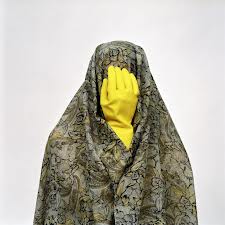Veiled Content
Hidden Meaning
Many artists prefer to work with meaning in a subtle or indirect manner, especially when the subject matter is potentially inflammatory or where censorship exists.
In this teaching idea for year 1 students, who still need some clearly teacher directed assignments. We begin by looking at examples of artists who work with hidden content. You may want to consult the teachers notes on the Contemporary Artists from the Middle East page, or look up some of the resources listed at the end of the page.
Controversial Subject matter
Censorship exists around controversial subject matter. Teachers in schools where Islam is the way of life often ask me how to work with this when many subjects are not considered appropriate for their students art work. My suggestion is to work with hidden content, make the mystery part of the art. Without being explicit or confrontational, touchy subjects can be addressed creatively.
Pictured here is a work by the artist Maliheh Afnan (Iran-UK), Veiled threats, ink on paper overlaid with gauze, 2006
In this work Maliheh Afnan has written with ink on paper then overlaid her text with a piece of thin, openwork fabric. This gauze subtly evokes the idea of the veil, which is worn by many women across the Middle East. Afnan invests the veil with a number of different meanings, and has said that it veils 'not only women but threats and intentions' (personal communication to the curator). The patterns that Afnan has created resemble letters but are an invented artistic vocabulary inspired by ancient Middle Eastern scripts.
Afnan was born in Haifa, Palestine, to Iranian parents. She studied in the United States and Lebanon then subsequently worked in Kuwait, Lebanon, France and England (where she now lives).[1]
Reflection and Investigation
Consider how materials and meaning are entwined. What is being veiled? Are there layers of meaning as well as physical layers? In Veiled Threats, is the difficulty in deciphering the message central to the piece?

Iranian photographer, Shadi Ghadirian, takes a less subtle, more humorous approach. In the C-print photo on the right, Domestic Life #61, 2002, one from the series Like Everyday ( Domestic Life), she uses the veil very literally. Is the content here really veiled or is it unveiled?
"Shadi...plays with the notion of “woman as object” by presenting completely veiled silhouettes in traditionally patterned fabrics with everyday kitchen utensils – a pan, a glove, a spoon – substituted for the face. Through her work, Ghadirian explores the position of contemporary women in a society dominated by masculine stereotypes, and conflicts between tradition and modernity.[2]
Comparison
Compare these two works and discuss their different approaches to the veil and to masking or unmasking content.
Independent Research
Each student should write about their own choice of an artist who works with hidden content.
 Studio Work
Studio Work
Development and Refinement of Ideas
For the studio component, try inventing other routes for investigating topics where direct confrontation is not a possibility. Through the uses of materials, symbols, allusions and metaphor, can you present an idea without exposing it directly? The challenge is to address obliquely an issue that you don’t feel comfortable with expressing openly.
Make the mystery a part of the work.
Download Veiled Content
Resources for Research
(This would make an excellent EE topic!)
Alternative narratives of the Veil in Contemporary Art, by Valerie Behiery
http://cssaame.dukejournals.org/content/32/1/130.abstract
http://democrati.net/2012/04/24/exploring-the-veil-in-art/
The Seen and the Hidden: (dis)covering the Veil
http://www.acfny.org/press-room/press-images-texts/the-seen-and-the-hidden-discovering-the-veil/
MORE ARTISTS
Negar Ahkami (USA), Ayad Alkadhi (Iraq/USA), Zoulikha Bouabdellah (Algeria/France), AdrianaCzernin (Bulgaria/Austria), Katrina Daschner (Germany/Austria), Shadi Ghadirian (Iran), Nilbar Güres
(Turkey/Austria), Marlene Haring (Austria), Farheen HAQ (Canada), Princess Hijab (France), Hannah
Menne (Austria), Sara Rahbar (Iran), Marjane Satrapi (France), Asma Ahmed Shikoh (Pakistan/USA),
Esin Turan (Turkey/Austria)

